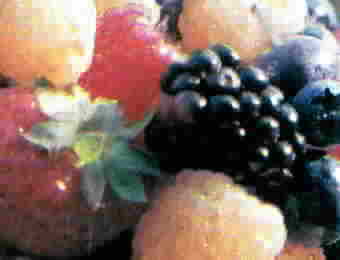FRUIT SUBSTITUTE

Usage: So successful have fruit substitutes become as "edible signs" (i.e., as foods suggesting the presence of ripe fruits and berries), that they are as common in the modern diet as fruit itself. A fruit substitute's sweetness usually comes from table sugar (sucrose), a crystalline carbohydrate which suggests the fruity sweetness of fructose (for which--as a nonverbal sign--it stands). Today's fruit substitutes reconnect us to our fruit-eating, primate past.
Juicy fruit. When primates took to the trees ca. 50 m.y.a. in the Eocene, they supplemented a basically insect diet with ripened fruit. The evolution of our "sweet tooth" is reflected in our ancestors' teeth. Insect-eaters had spiked cusps on their molar teeth, while fruit-eaters had flatter, rounder molars for grinding. Eocene-primate molars show a flattened adaptation for pulping fruit flesh (the better to taste its fructose). Our tricuspid teeth enable us to pulp grapes, bananas, and Juicy Fruit chewing gum.
Tasty fruit. Fourteen m.y.a., as Miocene primates descended from trees to the terrestrial plain, a powerful appetite for fructose descended with them. Today, combining sweetness with ca. 300 varieties of flavor molecule, strawberries are among the tastiest of real fruits. With ca. 200 flavors, raspberries also delight the tongue. Bananas are less flavorful, yet their 17% sugar content--which ties them for "sweetest" with the Chinese litchi--has helped make bananas the world's best-selling fruit (Hockstader 1992).
Tastykakes. And yet, bananas are still not sweet enough, because it is a peculiarity of our species that we indulge our primate sweet tooth with fruit substitutes rather than with actual fruit. Half of the U.S. population, e.g., does not eat a single piece of fresh fruit a day (Sugarman 1992). In a lifetime, Americans eat more candy (1,500 lbs.) than apples (1,400 lbs.; Heyman 1992). Apples, oranges, and raspberries have bowed to sweeter-tasting candies and pastry products, such as Tastykakes, which encode more chemical information, and have more to "say."
Flavor. Decoded in the chemical channels for taste and smell, a piece of fruit is usually no match for a baked good. As culinary signals, cookies and donuts are designed to send far more complex sets of messages a. to tongue receptors, through sweet--as well as salty--tastes, and b. to nasal receptors, through rich caramelized aromas of baked sucrose and deep-fried fat. A banana's natural flavor molecules (called esters) are pleasant, but are no match for the salty-sweet, buttery taste, and resonant aroma, e.g., of strudel.
Prehistory. Giving sweets (e.g., sugar cane, butter creams, and chocolate-covered ants) is a "friendly" gesture in all societies. The earliest prehistoric candy may have been bee honey, which is still a popular commodity among living hunter-gatherers, such as the !Kung Bushmen, today. In written history, honey is mentioned in ancient hieroglyphic texts, as in, "Honey for the funeral procession of the [Egyptian god] Osiris" (Martin 1991:182).
Today. Earth's best-selling fruit substitute is Life Savers. Over 35 billion rolls have been sold since 1913 (McFarlan 1990). Had they grown on trees, the colorful candies might have appealed to Miocene-primate tongues as well. Indeed, in the U.S.A. today, a candy bar is more appealing--and psychologically more "real" as food than an orange or a tangerine. (N.B.: There are no seeds, and a candy bar's "peeling substitute" is easier to remove.)
Neuro-notes. Sweetness stimulates taste buds of the tongue tip, which convey signals through the facial nerve, via the hindbrain, to the forebrain. There, the message splits, as part travels a. to unconscious areas of the limbic system (amygdala and lateral hypothalamus), and b. to the conscious cerebral cortex (via thalamic relays to the postcentral gyrus and insula). (N.B.: That we crave sugar instinctively is suggested by babies born without a cerebral cortex, who respond to sweet but reject bitter tastes.)
See also JUICE SUBSTITUTE, NUT SUBSTITUTE.
Copyright 1998 - 2016 (David B. Givens/Center for
Nonverbal Studies)
Photo of fruit (picture credit: unknown)